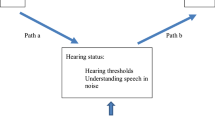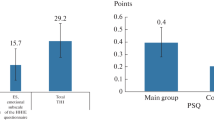Abstract
302 subjects with normal hearing for their ages in the age group of 10 to 80 years were subjected to pure tone audiometry. First, steep reduction in hearing was observed in the age group between 40 to 49 years. Males were found to have better hearing acuity in lower frequencies and females in higher frequencies, in older age groups. Better hearing acuity was observed in upright as compared to supine posture. No relationship could be established between economic status of an individual and his hearing.
Similar content being viewed by others
References
Banerjee, M. N. (1931) Disparity in binaural acuity.Indian Journal of Psychology,6: 125–141.
Bunch, C. C. and Raiford, S. B. (1951), Race and sex variation in auditory Acuity.Archives of Otolaryngology,13: 424–434.
Corso, J. F. (1962), Bodily positions and auditory thresholds.Perceptual and motor skills,14: 499–507.
Feldman, R. M. (1968), Effects of increased cerebrospinal fluid pressure on C.M. response.Journal of Hearing Research 11: 18–32.
Foucault Marcel, L’acuite visuelle et L’ acuite Auditine chez les Ecoliers.Anne. Psychologique,26: 79–91.
Kekcheev, K. K. H. (Night vision:how better to see in the dark.)Moscow sovetsk Nauka, 1946 (Quoted by Ref. No. 3).
Kennedy, H. (1941), A studyof children’s hearing as it relates to reading. A university of Chicago dissertation. 1941.Journal of Experimental Education, 10: 238–251 (Quoted by ref. No. 8).
Kennedy, H. (1957), Maturation of hearing acuity.Laryngoscope,67: 756–762.
Kerth, J. D. & Allen G. W. (1963), Comparison of perilymphatic and cerebrospinal fluid pressure.Archives of Otolaryngology,77: 581–585.
Keys, A. M.; J. Karvenson & F. Fidanza (1958), Serum cholesterol studies in Finland.Lancet,2: 175.
Lebo, Charles, R., Rayford, C. Reddel, (1972), The presbyacusis component in occupational hearing loss.Laryngoscope,82: 1399–1409.
Lenihan, J. M. A., Christie Fulton J. Russel T. S., Margaret N. M., D. C. Hamilton and Elizabeth C. (1971), The threshold of hearing in school children.The Journal of Laryngology and Otology,85: 375–385.
Miltich, A. J., (1968), Human auditory threshold shifts following changes between upright, supine and inverted bodily positions.The Journal of Auditory Research,8: 367–377.
Rosen, S. M., Bergman, D., Plester, A., ElMofty and Satti M. H. (1962), Presbyacusis study of a relatively noise free population in Sudan.Annals of Otology & Rhinology & Laryngology,71: 727–743.
Rosen, S. N. Probrajensky, S. Khechunaschuvilli, T.; Glazunov, N.; Kipschidze and H. Rosen. (1970), Epidemiologic hearing studies in the U.S.S.R.Archives of Otolaryngology,91: 424–428.
Sataloff, J. & Menduke H. (1957), Presbyacusis,Archives of Otolaryngology,66: 271–274.
Author information
Authors and Affiliations
Rights and permissions
About this article
Cite this article
Sharma, R., Bhargava, R.P. Auditory assessment in relation to age, sex, bodily posture and economic status in normal individuals. Indian J Otolaryngol 31, 1–3 (1979). https://doi.org/10.1007/BF02992240
Issue Date:
DOI: https://doi.org/10.1007/BF02992240




